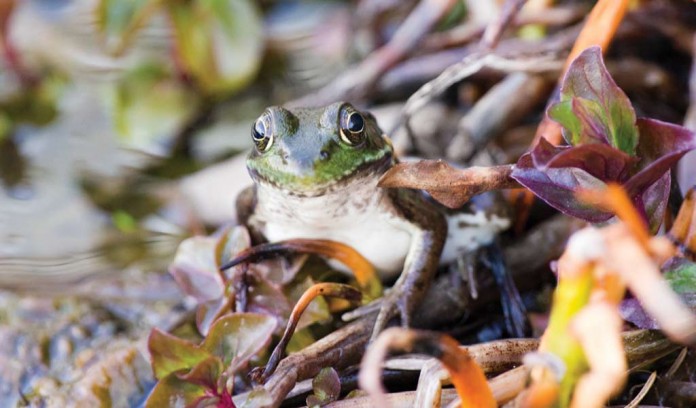Two weeks ago I described vernal pools, ephemeral bodies of water that can range in size from puddles to large shallow ponds.
Among other purposes, they serve as breeding areas for a variety of frogs and salamanders. Because the pools dry up before the end of summer, they cannot sustain fish, which would otherwise eat the eggs and larvae of these amphibians.
Safe haven
This makes vernal pools a safe haven for amphibian reproduction and underscores the critical nature of such ephemeral habitats.
Breeding activity often begins while snow still covers the ground. Warm late winter and early spring rains send frogs and salamanders to these pools, which have often been used by previous generations. A walk in the woods after dark during a gentle rain in March is an easy way to find and observe these breeding aggregations. All that’s required is a flashlight and waterproof boots.
Frolic in woodland pools
Of course, many people (perhaps most) are unwilling or unable to venture out into a chilly, rainy March evening to see frogs and salamanders frolic in woodland pools. So many armchair naturalists only get to read secondhand accounts of these behaviors.
Technology has changed that. Now anyone with an internet connection can see these behaviors while watching a computer monitor.
The perfect storm
Lang Elliott, one of the world’s premier nature photographers, cinematographers, and sound recordists, is based near Ithaca, N.Y., and he blogs about natural sounds and images at www.langelliott.com. With Lang’s permission, here’s the introduction to a recent post entitled, “Salamander Migration Extraordinaire”: “It was a ‘perfect storm.’
Magic formula
An early March warm spell. The daytime temperature rose into the low 60s (Fahrenheit) and then it rained all afternoon. This is the magic formula that stirs mole salamanders into action. When darkness prevails, out of the earth they climb and then trek toward their breeding sites . . . vernal pools, small ponds, and temporary streams.”
Watch salamanders
At that point, readers can click on the video stream and get an overhead view of beautifully marked spotted salamanders writhing in a chilly pool while spring peepers sing in the background. Then he places his camera in an acrylic case and shoots the scene from underwater — a salamander’s eye view of life in a vernal pool. Now, while staying warm and dry, anyone can see behaviors that, heretofore, only crazy field biologists and nature photographers got to see.
Explore Lang’s blogs, and you’ll find many irresistible posts. See and hear frogs and toads at a beaver pond.
The sky dance
Listen to a hermit thrush sing at dusk. And watch an American woodcock “peent” as it prepares for its sky dance.
Each clip lasts just a few minutes, so you can observe many behaviors in just a short time.
If you want more, Elliott offers 60- to 70-minute mp3 files and CDs sans music or human voices — just the sounds of nature. Sounds include dawn songs, insects, frogs, babbling brooks, loons, owls, and more.
Shop at www.musicofnature.com; mp3 files are $10, CDs are $12.
Salamanders and children
Another extraordinary reference featuring salamanders will be published in April, and it’s a children’s book. Salamander Dance by David FitzSimmons (2016, Wild Iris Publishing, $17.99) is a beautifully illustrated and accurate natural history of spotted salamanders.
It’s sure to get kids of all ages to fall in love with salamanders.
Salamander Dance takes readers from subterranean burrows where these amphibians spend most of their lives to the vernal pools where eggs are laid and juvenile salamanders grow and mature.
Book awards
Unlike FitzSimmons’ previous Curious Critters picture book series (www.curious-critters.com), which have won nine national book awards and which the author illustrated with his own photographs, Salamander Dance comes to life with color paintings by nature artist Michael DiGiorgio. His superb images will no doubt have more than a few young readers begging for nocturnal field trips into the woods to explore vernal pools.
I’m confident Salamander Dance is destined to become one of my grandsons’ favorite nature books.













